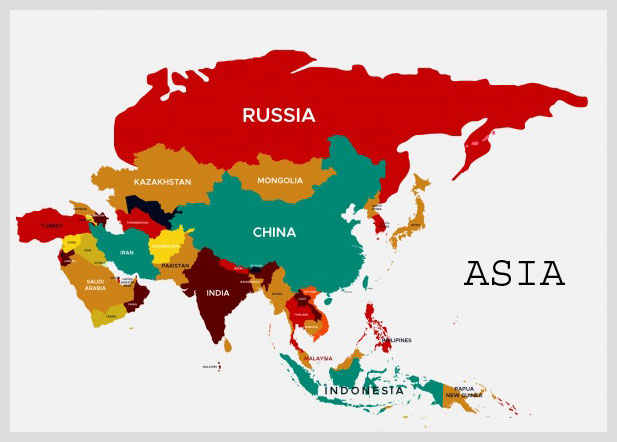Asia is the largest and most populous continent on Earth. It covers about 30% of the world's total land area and is home to more than 4.7 billion people – over half of the global population. Asia is known for its rich history, diverse cultures, unique landscapes, and rapid economic growth.

It is the world's largest and most diverse continent, covering about 30 percent of the land area on Earth.
The name Asia is ancient, and its origin has been variously explained. The Greeks used it to designate the lands situated to the east of their homeland. It is also believed that the name may be derived from the Assyrian word asu, meaning "east."
Asia is bounded by the Arctic Ocean on the north, the Pacific Ocean on the east, the Indian Ocean on the south, the inland seas of the Atlantic Ocean--the Mediterranean and the Black--on the southwest, and Europe on the west. Asia is separated from North America to the northeast by the Bering Strait and from Australia to the southeast by the mingled waters of the Indian and Pacific oceans. The Isthmus of Suez unites Asia with Africa, and it is generally agreed that the Suez Canal forms the border between them. Two narrow straits, the Bosporus and the Dardanelles, separate Anatolia from the Balkan Peninsula.
Asia spans both the Northern and Eastern Hemispheres. It is bordered by the Arctic Ocean to the north, the Pacific Ocean to the east, the Indian Ocean to the south, and Europe to the west. Asia is often joined with Europe in the landmass called Eurasia.
The continent includes vast deserts like the Gobi Desert, towering mountain ranges such as the Himalayas (home to Mount Everest, the world's tallest mountain), tropical rainforests, and massive rivers like the Yangtze, Ganges, and Tigris-Euphrates.
Asia is made up of 49 countries, including:
Other notable countries include South Korea, Saudi Arabia, Thailand, Vietnam, Pakistan, and the Philippines.
Asia has the highest average elevation of the continents and contains the sharpest relief. The highest peak in the world, Mount Everest, which is 29,035 feet (8,850 metres) high; the lowest place on the Earth's land surface, the Dead Sea, which averages about 1,312 feet (400 metres) below sea level; and the world's deepest continental trough, occupied by Lake Baikal, which is 5,315 feet (1,620 metres) deep and whose bottom lies at 3,822 feet (1,165 metres) below sea level, are all located in Asia. These physiographic extremes and the overall predominance of mountain belts and plateaus are the result of Asia's prolonged and intense geologic activity. Asia is the youngest of the continents; broadly speaking, it consists of several ancient platform cores, which over time accumulated immense quantities of material around them and were subjected to a series of collisions with one another that resulted in uplifting along the zones of collision.
The mountain systems of Central Asia have provided the continent's great rivers with water from their melting snows.
Also as a result of this configuration, Asia's population is unevenly distributed. There is a concentration of population in western Asia as well as great concentrations in the Indo-Pakistan subcontinent and the eastern half of China and appreciable concentrations in the Pacific borderlands and on the islands; but vast areas of Central and North Asia have remained sparsely populated. Nonetheless, Asia, the most populous of the continents, contains almost three-fifths of the world's people.
Asia is home to many ancient civilizations like Mesopotamia, the Indus Valley, and Imperial China. It is also the birthplace of major world religions:
Languages spoken across Asia include Chinese, Hindi, Arabic, Japanese, Russian, Korean, and hundreds of regional dialects.
The enormous expanse of Asia and its abundance of mountain barriers and inland depressions have resulted in great differences among regions in existing conditions of solar radiation, atmospheric circulation, and climate as a whole. Climates in Asia range from that of the equatorial rain forest to that of the Arctic tundra. For the most part, the northern part of Asia is dominated by movement of polar continental air masses that travel from western Siberia to the northern Pacific. Winters here are long and harsh, summers are short and cool, and the annual precipitation is light. A similar climate is characteristic of the Tibetan Plateau and other uplands. The interior regions have middle-latitude desert or semiarid climates, with harsh winters and warm to hot summers and an average annual precipitation of less than 230 mm (less than 9 in). The southern and eastern margins of the continent, however, are characterized by monsoonal air movements from the cold interior east and south in winter and from the oceans north toward the warmer land in summer. For the most part the margins of Asia have cool to cold, dry winters and hot, humid summers, with a strong concentration of rainfall in the summer months.
Asia includes some of the world's largest economies, such as:
Many Asian countries are experiencing rapid development, but some still face challenges related to poverty, education, and access to healthcare.
Asia is famous for its rich and diverse food culture. Each country in Asia has its own unique dishes, ingredients, and cooking styles.
Many Asian dishes use fresh herbs, spices, rice, noodles, and seafood. Street food is also very popular in Asian countries, offering quick and tasty meals.
Asia's food is not only delicious but also reflects the history, culture, and traditions of each region.
Central Asian arts encompass a rich and diverse cultural tapestry shaped by centuries of interaction between nomadic tribes, ancient empires, and global trade routes such as the Silk Road. This region, which includes countries like Kazakhstan, Uzbekistan, Turkmenistan, Kyrgyzstan, and Tajikistan, has long been a crossroads of civilizations, resulting in a unique blend of artistic expressions.
Asia also hosts natural wonders like the Dead Sea, Lake Baikal, and the Himalayan Mountains.

Try out the other sections